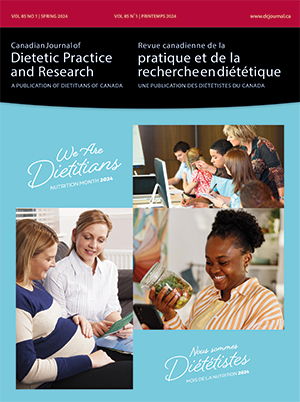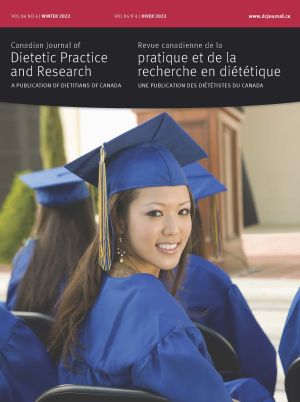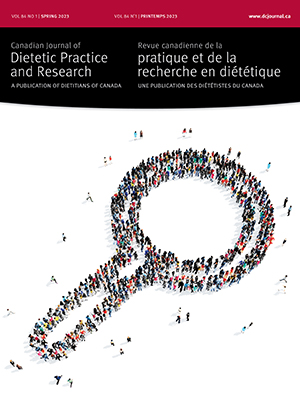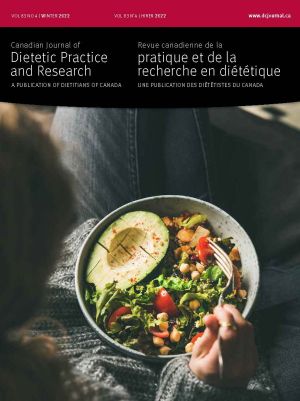Volume 70 • Number 1 • March 2009
Chair’s Message
Editor’s Message
Research
Purpose: The symbolic meanings that youth associate with food were explored, as were barriers to accessing healthy foods. Methods: Qualitative methods and a constructivist approach were employed, and data were collected through semi-structured interviews and a card-sorting activity. Thirteen adolescents aged 13 to 15 (seven girls, six boys) were recruited through public schools and posters displayed in community settings. Thematic analytical techniques were used to analyze the data. Results: Participants classified foods into healthy and unhealthy groups, as well as into an “in-between” group that included nutritionally enhanced foods. Healthy and unhealthy foods were linked to a variety of physical, social, and emotional meanings. Some meanings associated with foods were also discussed in gendered terms, and numerous barriers to accessing healthy foods were reported. Conclusions: Foods hold multiple meanings for youth. Programs and policies aimed at fostering healthy eating need to capitalize on positive associations related to healthy foods. Negative associations related to healthy foods need to be acknowledged and strategies developed to recast such linkages. Likewise, the positive associations linked to unhealthy foods need to be addressed. Strategies also need to be developed to ensure access to healthy foods in all settings, especially within schools and community leisure settings.
Purpose: The number of visually impaired and blind Canadians will rise dramatically as our population ages, and yet little is known about the impact of blindness on the experience of food and eating. In this qualitative study, the food experiences and eating patterns of visually impaired and blind people were examined. Influencing factors were also explored. Methods: In 2000, nine blind or severely visually impaired subjects were recruited through blindness-related organizations in British Columbia. Participants completed individual semistructured, in-depth interviews. These were transcribed verbatim, coded, and analyzed to explicate participants’ experiences. Results: Participants experienced blindness-related obstacles when shopping for food, preparing food, and eating in restaurants. Inaccessiblematerials and environments left participants with a diet lacking in variety and limited access to physical activity. Seven participants were overweight or obese, a finding thatmay be related to limited physical activity and higher-than-average restaurant use. Conclusions: This is the first study in which the experience of food and eating is described from the perspective of visually impaired Canadians. Nutrition and blindness professionals must work together to reduce the food-related obstacles faced by visually impaired and blind people. Professionals must address both individual skill development and social and structural inequities.
Purpose: Calcium and vitamin D intakes from food and supplements were estimated in Canadian men and women. Methods: Calciumintakes fromboth diet and supplements and vitamin D intakes fromfortifiedmilk and supplements were estimated using cross-sectional data from9423 randomly selected subjects aged 25 years or older, who were participating in a longitudinal study on osteoporosis. Subjects completed an abbreviated food frequency questionnaire administered by a trained interviewer between July 1995 and December 1997. Results: Themean (standard deviation) daily intake for calciumwas estimated to be 1038 (614)mg for women and 904 (583)mg formen; for vitamin D,mean intakes were 5.6 (5.9) μg and 4.8 (5.5) μg for women andmen, respectively. Conclusions: Mean intakes for calcium and vitamin D in men and women under age 51 were close to the adequate daily intake levels. Older adults, however, may be at risk of deficiency.
Purpose: South Asian immigrants to Canada are at high risk for developing diabetes, and culturally relevant diet counselling tools are needed. We examined perceived needs and preferences for diet counselling resources based on the newly revised Canadian Diabetes Association meal planning guide. Methods: Five focus groups of individuals fromdifferent regions of South Asia (n=53) discussed portion size estimating methods, cultural values and holidays, food group classifications, and common South Asian foods. A focus panel with dietitians (n=8) provided insight on current diabetes educationmethods and resources for teaching South Asian clients. Results: The dietitian panelmembers reported a need for resources targeted at differing client skill levels. They also noted preferences for individual counselling, and common barriers to education including finances, access, South Asian diets, and cultural views on health. Community focus groups reported larger portions but fewer dailymeals in Canada. Ingredients and portions were notmeasured. Fasting was an important value, and sweets were a crucial component of holidays. Resources in South Asian languages, inclusion of pictures, and separate legumes, sweets, and snacks food groups were preferred. Conclusions: Findings can be used when developing new counselling tools for the South Asian community.
Perspectives in Practice
The Canadian Institute for Health Information (CIHI) provides accurate health information needed to establish sound health care policies. The CIHI mandate is to develop and coordinate a uniform approach to health care information in Canada. The institute uses the International Classification of Diseases (ICD) system to record the most responsible diagnosis for each hospital admission. This investigation was conducted to determine if six ICD protein-calorie malnutrition (PCM) codes could be used for health care utilization analyses. Aggregate data (1996 to 2000) from the CIHI discharge abstract database were used. The data analyzed were the most responsible diagnoses data for the six PCM codes and a single summary statistic for all other “non-malnutrition” diagnoses for all long-term care facility residents aged 65 or older who were transferred to an acute care facility. In this population, fewer than five hospital admissions per year were assigned a PCM code. There were too few PCM cases to do trend analyses for morbidity or mortality. This study suggests a lack of recognition and documentation of PCM as a specific health condition in older adults. Lack of tracking of this diagnosis prevents documentation that could lead to policy changes to support older adults’ nutrition.
Report
Purpose: Middle-aged women have the highest levels of obesity and comprise the largest group of dieters. Few investigators have examined how women apply weight-loss diet principles in an unsupervised setting. Dietary intakes and attitudes toward carbohydrates were examined in women who were selfreported low carbohydrate dieters (SRLCDs); these intakes and attitudes were compared with those of women who were following their normal diet (non-dieters [NDs]). Methods: A convenience sample of 29 postmenopausal women aged 45 to 65 was recruited. Data were obtained by interview, questionnaire, and direct anthropometric measurement. Descriptive statistics, chi-square analysis, and analysis of variance were used to compare groups. Results: Although total energy and protein intakes were similar, SRLCDs consumed significantly more fat and less carbohydrate (expressed as a percentage of total energy) and more cholesterol and less fibre than did NDs. Both groups had unfavourable attitudes toward carbohydrates. Conclusions: The SRLCDs ate more fat than recommended. Women who are considering following a low carbohydrate diet need to know the nutritional risks of unbalanced self-designed low carbohydrate diets. Negative attitudes toward carbohydrates were not confined to dieters. Nutrition education is necessary to help consumers understand basic nutrition principles and to be more skeptical of fad diets.










